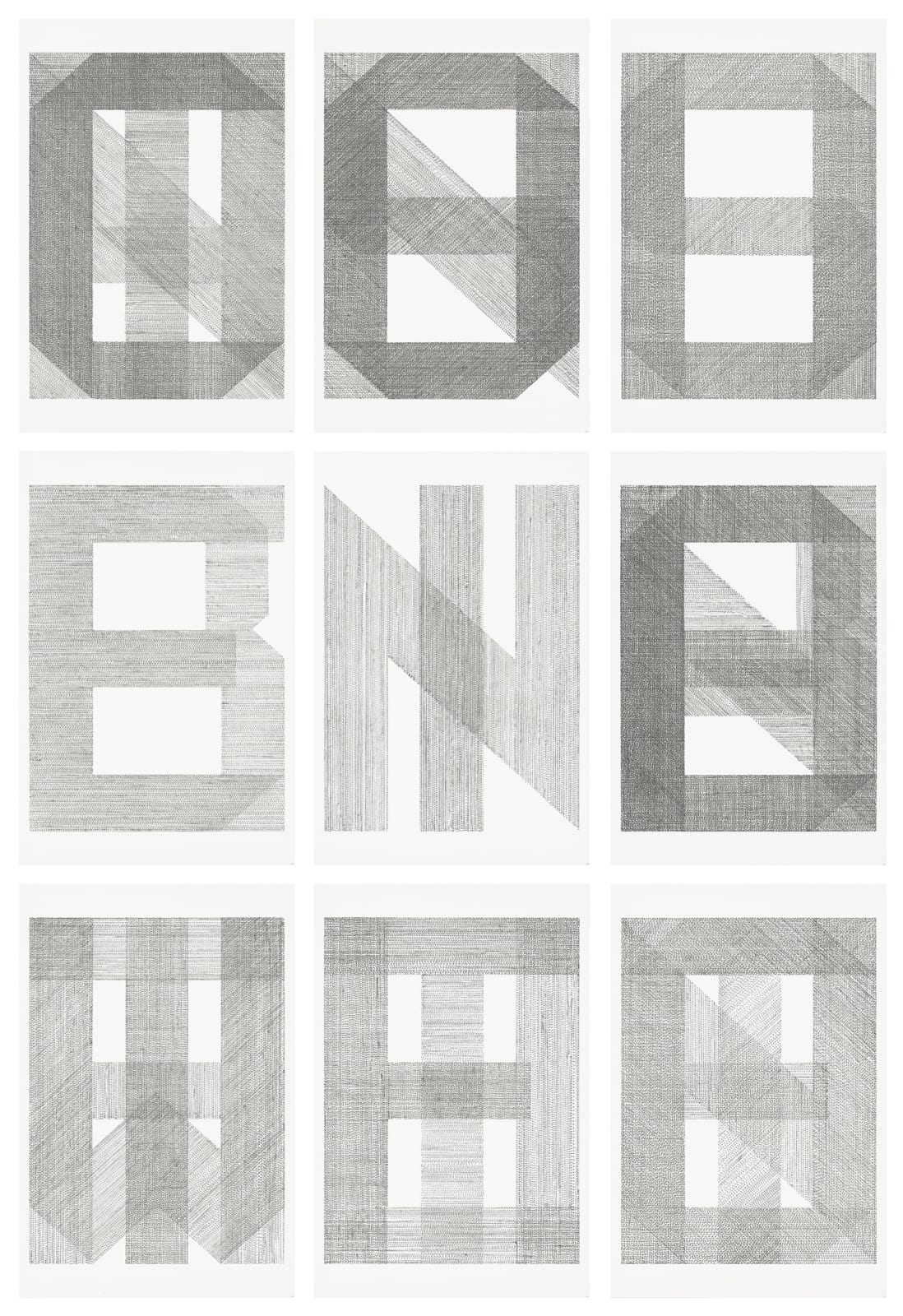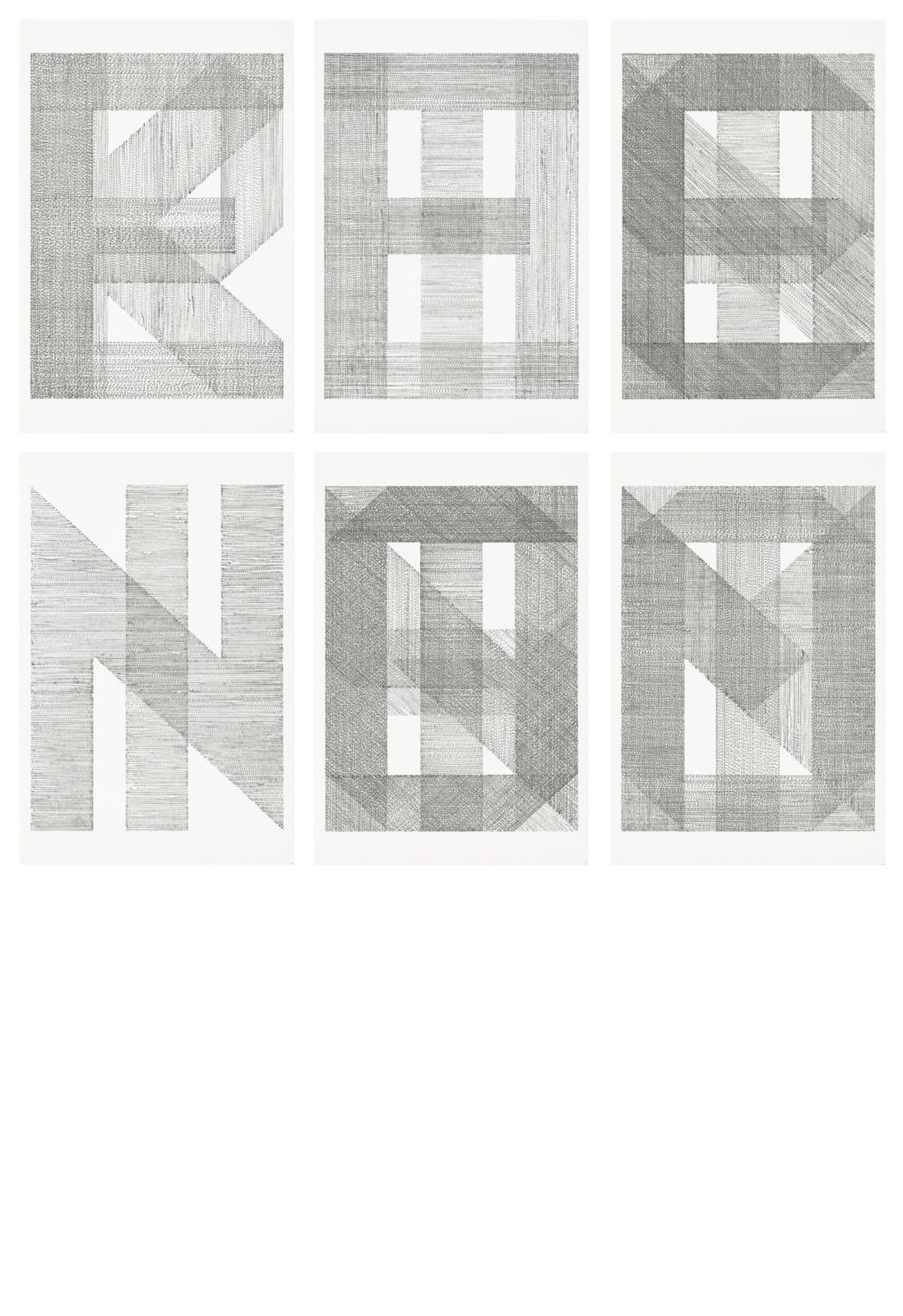MONO SPACES: 알렉산드라 로젠 Alexandra Roozen
알렉산드라 로젠의 전시 제목은 모든 글자의 폭이 같은 글꼴을 의미하는 타이포그래피의 용어, ‘모노스페이스(Monospace)’에서 기인했다. 이번 개인전을 통해 처음으로 공개되는 TRACES 시리즈는 이 모노스페이스 방식을 응용해서 글자를 층층이 쌓아 올린 작품이다. 그런데 TRACES 시리즈 외에 기존의 MONO 시리즈와 FEW 시리즈도 함께 선보이는 전시에 그가 <MONO SPACES>라는 제목을 붙인 이유는 무엇일까. 작가는 TRACES 시리즈를 진행하기 전부터 작업을 시작할 때 일정한 그리드를 기반으로 했기 때문에 자신은 이미 그 방식을 사용하고 있다는 것을 깨달았다고 한다. ‘모노스페이스’는 그의 모든 작업에 내재된 규칙이다.
TRACES 시리즈는 작곡가 빌렘 부그만(Willem Boogman)과의 인연에서 시작됐다. 로젠의 작품에서 음악적인 요소를 발견한 부그만은 작가의 기존 작품을 음악으로 옮기는 프로젝트를 시도한다. 이렇게 만들어진 악보의 여백 공간에는 연주자들을 위한 지시어들이 적혀 있었다. ‘윤곽만 알아볼 수 있도록 흐릿하게’, ‘다른 음과 음색의 균형을 맞춰서’, ‘한 번의 호흡으로 끝까지 연주할 것’, ‘가볍게 강조할 것’. 악보를 본 작가는 이 추상적이고 시적인 지시어들이 계속 머릿속에 메아리처럼 맴돌았고 그 여운으로 TRACES 시리즈를 시작하게 됐다고 한다. 연주자와 같이 몸을 움직여 작업하는 그에게 그 단어들은 마치 자신에게 지시하는 것처럼 들렸을지 모른다.
로젠의 작품에는 이미 음악적 요소가 담겨 있다. 작품의 제작 과정을 담은 영상인 <Seen by Hand>(2018)는 제작 과정에서 발생하는 소음이 결과물과 관계가 있다는 것을 보여준다. 종이와 연필을 매체로 사용하는 그는 직접 손으로 연필을 쥐고 종이에 선을 그을 때, 여러 자루의 연필을 고정할 수 있는 도구를 사용할 때, 그리고 전동드릴을 이용할 때 연필이 종이에 스치는 다양한 소리를 만들어 낸다. 대부분 규칙적이지만 때로는 작가도 의도하지 않은 소리가 만들어진다. 인간의 몸은 일정한 속도와 동일한 움직임을 유지하려고 하더라도 변수가 발생하기 마련이다. 그런데 이것은 전동드릴도 마찬가지이다. 몸동작의 미세한 변화 및 드릴의 회전수와 속도의 변칙은 획이 곧지 않고 선이 끊긴 흔적을 남긴다. 즉, 규칙적인 수기 행위(hand-writing)의 변수가 발생하는 것이다.
수기 행위는 로젠의 작업에 가장 큰 영감을 주는 요소이다. 그의 작업은 MONO 시리즈와 FEW 시리즈처럼 이 수기 행위의 손놀림 및 종이와 연필의 물질성을 담은 추상적인 이미지 즉, 필흔으로만 존재했다. 그런데 TRACES 시리즈는 의미를 가장 명확하게 전달(하고자)하는 문자를 사용했다. 하지만 문자는 때때로 잘못 전달되기도 하고 본래의 뜻과 다르게 해석되기도 한다. 작가는 문자를 겹쳐 놓음으로써 그 뜻을 알아볼 수 없도록 했지만, 하나의 이미지로서 새로운 가능성을 탐구한다. 노동집약적인 수기 행위를 통해 종이에 새겨 넣은 중첩된 문자는 여전히 ‘문자’로 존재하는가? 아니면 그저 ‘필흔’으로 존재하는가? 이 질문에 답을 내리는 것은 작가가 아닌 어쩌면 관람자의 몫인지 모른다.
작업의 음악적 요소와 반복적인 수기 행위의 시각화는 종이와 연필의 물리적 속성에서 비롯된다. 작가는 오래 전에 ‘회화는 무엇인가’라는 근본적인 질문을 자신에게 던졌었다. 이는 단지 캔버스의 표면에 담긴 이미지뿐만 아니라 캔버스 천, 프레임, 물감의 무게감과 색에 대한 의문을 모두 포함한 질문이었다. 그는 특히 물감의 색채에 담긴 상징성이 너무 과하다고 생각했고, 색채를 어떻게 사용할 것이지 해결하기 위해 회화의 가장 기본적인 단계인 연필 스케치부터 다시 시작하게 됐다. 종이와 연필은 매우 일상적이고 친숙한 도구이다. 그리고 그리기와 글쓰기는 모두 종이와 연필에서부터 시작된다. 사용법이 간단하고 직관적으로 표현이 가능한 연필로 종이에 선을 반복적으로 긋는 그는 지우개를 사용하지 않는다고 한다. 한 번 선을 그으면 아무리 지운다고 해도 종이는 예전의 흰색으로 되돌아가지 않는다. 연필의 편리성과 행위의 신중함 사이의 균형을 찾아가는 것이 그에게는 하나의 훈련 과정이다.
MONO 시리즈와 FEW 시리즈는 종이와 연필의 물성을 명확하게 보여준다. MONO 시리즈는 종이에 연필의 흑연을 켜켜이 쌓은 작업이다. 영롱한 검은 빛을 반사하는 흑연은 오랜 역사에도 불구하고 작가에게 여전히 가장 매력적인 소재라고 한다. 흑연이 포화한 종이는 마치 동물의 모피처럼 섬유 가닥이 헤지고 밀려 올라가 있다. 이렇게 종이는 쉽게 찢기고 헤지는 등 매우 연약한 소재이지만 한편으로 손이 베일만큼 날카롭고 또 질기다. FEW 시리즈는 물리적인 힘에 의해 움푹 들어간 자국을 보여준다. 얇은 음각과 양각을 보여주는 이 작업은 원래의 모습으로 복원되지는 않지만, 충격의 흔적을 껴안은 채 (나름 굳건히) 존재하는 종이의 성질을 드러낸다.
거칠게 말하자면, ‘모노스페이스’는 단지 로젠 작업의 물리적인 형식이 아닌 작업 세계의 근간을 이루고 있다. 그는 구조(물) 안에서 발생하는 불규칙성과 변수를 탐색한다. 구조에 균열이 나타날 때, 잠시나마 모든 논리와 이성이 무너지고 더 이상 그것이 통하지 않는 순간들 말이다. 이는 작업에서도 쉽게 찾아볼 수 있다. 선을 긋던 중 연필심이 흔들리거나 부러질 수도 있고 잠시 정신을 다른 곳에 팔릴 수도 있다. 그러한 과정에서 발생하는 모든 오류는 어쩌면 가장 ‘인간적인’ 부분일지 모른다. 작가가 전동 드릴로 선을 긋는 것은 인간의 ‘오류’를 피하려는 것이 아니다. 기계 역시 일시적인 결함이나 변수가 존재한다. 이 역시 ‘구조(물) 안의 불규칙성’이며 불완전함에서 오는 익숙함 또는 인간미를 보여준다. 누군가의 아름답고 독특한 필체는 결국 그 사람이 만들어내는 수기 행위의 규칙적이고 반복적인 ‘오류’에서 발생한다.
The title of Alexandra Roozen's latest exhibition is based on the typographic terminology monospace, or non-proportionally spaced fonts, where the space between characters are entirely equal, without accounting for proportional width of the characters themselves. The TRACES Series set to be revealed this exhibition are a collection of never-seen-before works. They are all applications of the monospace concept, of stacked letters. The TRACES Series is far from the only series of works to be exhibited. Roozen’s previous MONO Series and FEW Series also make an entry. What about TRACES lent its typographical concept to the overall exhibition title? Roozen recognized her previous works using a set grid of intervals as the kicking-off point. The iterative monospace pattern had been a recurring pattern in her works, merely not named as such.
Alexandra Roozen’s TRACES Series grew out of a creative connection with Dutch composer Willem Boogman. The Dutch composer had recently started a series of compositions (modulationes) in which he translates one form of musicality into another and had written a composition based on the music he “heard” in Roozen’s works. Performed by the renowned Ives Ensemble from Amsterdam, the composition’s scores contained plenty of textual clues written in the margins, for example: ‘Vaguely present, as a contour,’ ‘Contact sounds should be in balance with the tone,’ ‘In one breath,’ ‘Always light accents,’ etc. The notes of abstract and poetic clues resonated like a mantra long afterward, and eventually led to the development of the TRACES Series. The composer had recognized music in her works, but the artist may have found the words for her iambic movement and nature of her cadence and rhythm, movement and breathing, in the margins of the composer’s musical score.
Roozen’s previous works have contained elements of musical measures. Seen by Hand (2018), a short film documenting a creation of the artist’s work, auralized the sounds of drawing as an important part of her work. The artist works in the medium of pencil and paper. At times it is the hatching of a single pencil in her hand, or the scratching of hundreds of pencils fixed in a mega-holder she has created for the specific work. At other times, it is a rotating pencil driven by a rotating electric power-tool. Regardless of the mechanism, the meeting of the media create familiar yet diverse sounds. Some are metronomic and regular, while some are strange and unintended. With the human body involved and driving movement, even the most mantric movement is bound to variables. The hand-held electric drill is no exception. Accompanied by the mechanical rotating sound, the drill’s rotation results in a line that is neither continuous nor straight; an interrupted trail of small scratches and strokes. All that is to say, the variability of hand-writing behavior can be seen regularly in the artist’s pen-and-pencil works.
Alexandra Roozen elaborates on hand-writing as a constant source of inspiration. Her MONO Series and FEW Series have explored this through a degree of abstraction in the gesture, in the act of drawing, in the touches and traces, that reflect or reference the material. Her TRACES Series in that sense, has taken a first step towards figuration and recognizability through the introduction of handwritten characters capable of identification by viewers as characters, yet illegible as conduits of meaning. Characters and the meaning that they hold are often mis-conveyed and misinterpreted. The iterated and superimposed hand-written characters have depleted (or saturated) any impregnable meaning as text, but opened up new conduit possibilities as image. Do the superimposed characters etched into paper through labor-intensive handwriting exist as characters, still? Or are they merely traces? The answer to this question may be for the audience to fill in.
The musical element of drawing and the visualization of the iterative hand-writing come from the material properties of pencil and paper. ‘What is painting?’ is a fundament question that Alexandra Roozen has asked herself many times over. The question encompassed not only the canvas’ surface, but the fibrous material of the canvas itself, the frame, the substrate and pigments of color, their perceived gravity, and so on. In seeking answers, she found that the colors of paint where excessively laden with symbolic meaning and looked to pencil sketches as the more prototypal stage of painting. Pencil and paper are some of the most common and familiar tools, and drawing and writing both begin with pencil and paper. Intuitive to use, yet rich in expression, she uses the pencil to iterate lines on paper without the use of erasers. Once a line is drawn, no amount of erasing will return the paper to its original pristine tone. For Roozen, there is balance between the pencil’s convenience of use and the calculated rigor of execution.
The MONO and FEW Series clearly display the material characteristics of pencil and paper. The MONO Series is a collection of works where paper has been heavily saturated with pencil graphite. Roozen finds the ancient material deeply fascinating and very nuanced. Its ability to create a reflective buffer and shimmer captures the gaze despite its seeming simplicity and antiquity. The intense iterative process of saturating paper with graphite causes the strands of fibers to become hedged and tousled like fauvist fur. As such, paper can be very fragile and even flimsy as a material, tearing and wearing down easily, but it can be very resilient and even strong enough to cut through skin. The FEW Series shows relief-indentations from the application of intense physical pressure. Showcasing both degrees of intaglio and relief, the works present properties of paper that may not resilient or restored to its original state, but that captures and encompasses the traces of impact.
Roughly speaking, the concept of the monospace is less descriptive of the physical outcome and more expressive of Roozen’s practice in creating works. Her monospace works serve as a portal into the irregularities and variations within structures. When structures are breached and irregularities are observed, all logic and reason reliant upon that scaffolding also loses credulity. Those moments of breach and realization are where Alexandra Roozen’s monospace portals open to. The pencil may break or veer off-course from point A to point B. The hand might hesitate and the artist may be momentarily distracted. All errors there are perhaps what is most human about it all. The electric-drill line is not intended to avoid room for human error. Machines, mechanisms also undergo glitches and are affected by variables. This irregularities within structures gazes into imperfection with a sense of familiarity, even humanity. Handwriting, the individually beautiful and unique transfer of writing unto substrate, occurs out of the very iterative errors of human hand over paper.









